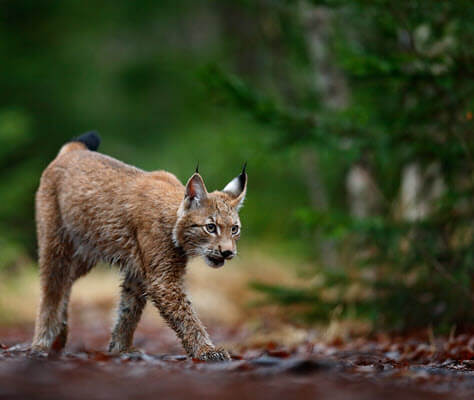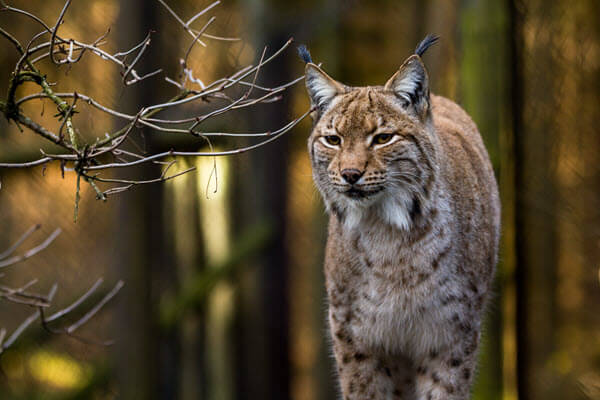The Eurasian lynx is known by many names, including the Siberian lynx, European lynx, Russian lynx and Northern lynx. It is the largest of the lynx species and broadly distributed throughout Europe, Siberia, Central Asia and East Asia. The home range of a Eurasian lynx can vary from 100 to over 1,000 km.
Several subspecies of Eurasian lynx have been identified, including the Carpathian lynx (Central Europe), Balkan lynx (Balkans), Caucasian lynx (Caucasus), Siberian lynx (Eastern Siberia) Turkestan lynx (Central Asia) and Northern lynx.
Scientific Name: Lynx lynx
Conservation Status: Least Concern, population is stable
About the Eurasian Lynx
Physical Appearance
The Eurasian Lynx is approximately 31 to 51 inches in length with a tail that is a little over 4 inches to almost 10 inches long. Females typically up to 46 lbs. and males up to 66 lbs. However in Siberia they can reach almost 100 lbs.
A Eurasian lynx has large web-like feet and long, strong legs. Their paws are like snowshoes , which increases their mobility in colder climates.
The fur of the Eurasian lynx is short. During summer months it can vary in color from reddish looking to brown. In the winter, their becomes much thicker and turns to a grey-silver or brown color.
Territory
 Most Eurasian lynx (almost 90%) live in Russia. They can also be found in northeastern Nepal, India, Turkey, Central Asia and Pakistan. Although once found throughout Europe, Eurasian lynx populations have nearly disappeared in that region. Efforts are currently underway to reintroduce the Eurasian lynx in various European countries. Currently there are approximately 2,800 living in the Carpathian Mountains and 2,000 living in Romania. Some Eurasian lynx have also been found in the Balkan peninsula. They primarily inhabit forests.
Most Eurasian lynx (almost 90%) live in Russia. They can also be found in northeastern Nepal, India, Turkey, Central Asia and Pakistan. Although once found throughout Europe, Eurasian lynx populations have nearly disappeared in that region. Efforts are currently underway to reintroduce the Eurasian lynx in various European countries. Currently there are approximately 2,800 living in the Carpathian Mountains and 2,000 living in Romania. Some Eurasian lynx have also been found in the Balkan peninsula. They primarily inhabit forests.
Hunting & Prey
The Eurasian lynx can kill prey up to four times its size. It preys on smaller mammals such as rabbits, squirrels, hares and marmots, as well as deer, young moose, wild boar, red foxes and grouse. It’s preference is for larger, hoofed animals. They have excellent vision and hearing, and will often climb onto rocks to look around for prey.
Reproduction and Lifespan
The female gestation period is 68 to 73 days. Litters consist of one to four kittens. The mother will leave her cubs after 10 months. The Eurasian lynx reaches sexual maturity at about two to three years of age. In captivity, they have lived up to 20 years.
Conservation
The major threats to the Eurasian lynx are habitat loss and poaching. Other threats include agriculture, ranching, mining, roads, railroad, logging and invasive species and diseases.

